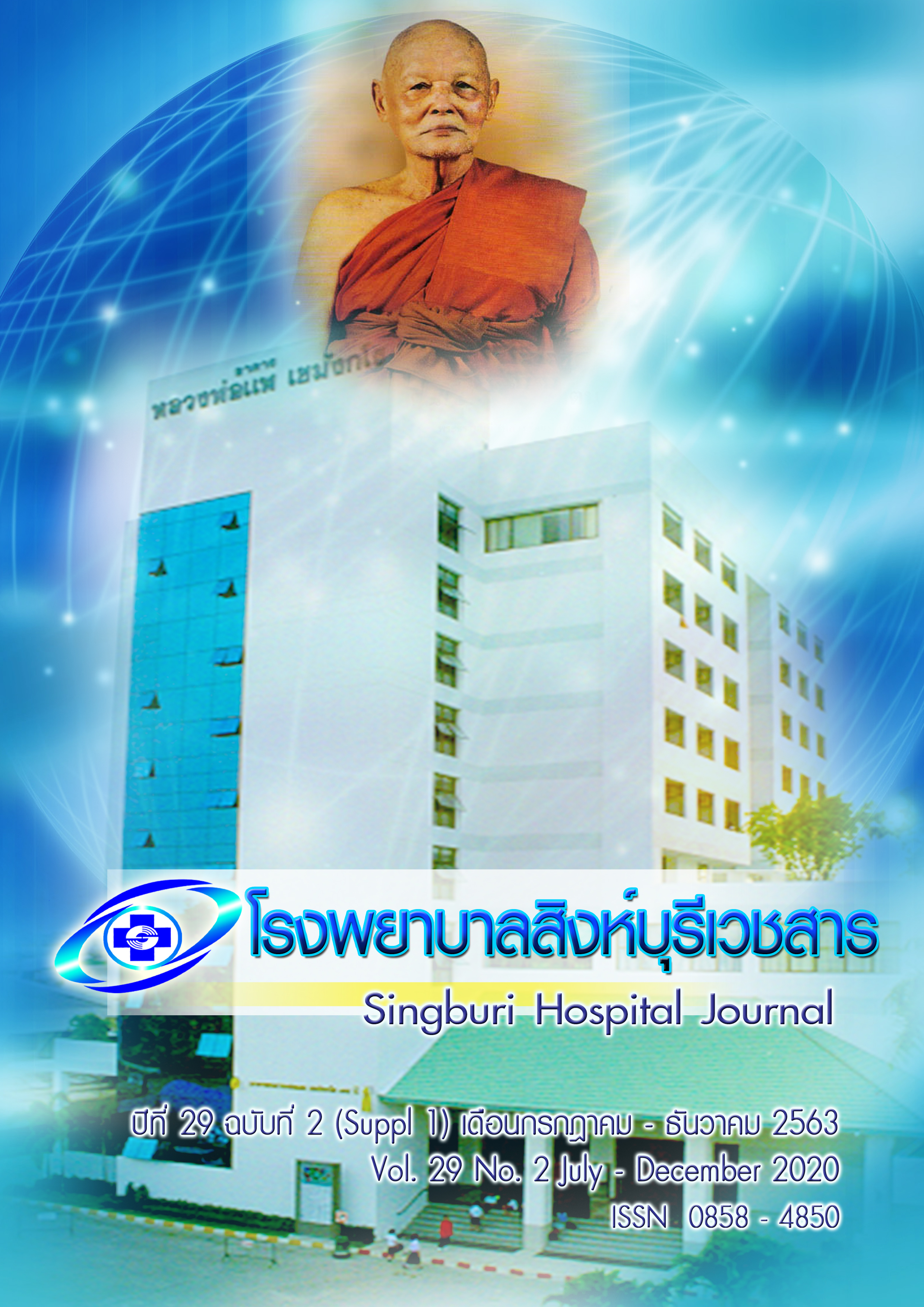ความชุกและความเสี่ยงของการเกิดภาวะจุดรับภาพชัดเสื่อมจากยาคลอโรควิน ในผู้ป่วยที่มารับการรักษาที่โรงพยาบาลอ่างทอง
คำสำคัญ:
จุดรับภาพเสื่อมจากยาคลอโรควิน, จุดรับภาพเสื่อม, คลอโรควินบทคัดย่อ
งานวิจัยเป็นแบบเชิงพรรณนาศึกษาย้อนหลัง (Retrospective study) เพื่อศึกษาความชุกและปัจจัยเสี่ยงของการเกิดจุดรับภาพเสื่อมจากยาคลอโรควินในผู้ป่วยโรงพยาบาลอ่างทอง โดยเก็บข้อมูลย้อนหลัง จากเวชระเบียนตั้งแต่ 2543 ถึง 2562
ผลการวิจัย พบว่า ผู้ป่วย 185 ราย เป็นเพศหญิง ร้อยละ 93 อายุเฉลี่ย 57 ปี เป็นโรครูมาตอยด์ ร้อยละ 60 ระยะเวลาที่ผู้ป่วยได้รับยาคลอโรควินมีค่ามัธยฐานคือ 1,246 (651, 2,261) วัน มีค่าเฉลี่ย ของขนาดยาคือ 4.56±0.98 มก. พบผู้ป่วยมีจุดรับภาพเสื่อมจำนวน 40 ราย (21.62%) และปัจจัยที่มีผลต่อการเกิดภาวะจุดรับภาพเสื่อมคือ คือ ขนาดยาต่อน้ำหนักตัวจริงต่อวันที่มากกว่า 4.6 มก./กก./วัน (OR 2.39; CI 1.04-5.46) และระยะเวลาการใช้ยานานกว่า 10 ปี (OR 4.61; CI 1.18-17.98)
ความชุกของจุดรับภาพเสื่อมจากยาคลอโรควินในการศึกษานี้คือ 21.62% พบผู้ป่วยมีจุดรับภาพเสื่อมได้เร็วที่สุด 258 วันหลังเริ่มยา ดังนั้นการตรวจตาควรทำครั้งแรกควรทำภายใน 8 เดือน และทำการตรวจทุกปีเพื่อป้องกันการสูญเสียการมองเห็นอย่างถาวร และปัจจัยที่มีความสัมพันธ์กับการเกิด คือ ขนาดยาต่อน้ำหนักตัวจริงต่อวันที่มากกว่า 4.6 มก./กก./วัน และระยะเวลาการใช้ยานานมากกว่า 10 ปี
Downloads
เอกสารอ้างอิง
Rynes RI. Antimalarial drugs in the treatment of rheumatological diseases. Br J Rheumatol. 1997; 36:799–805.
Cortegiani A, Ingoglia G, Ippolito M, Giarratano A, Einav S. A systematic review on the efficacy and safety of chloroquine for the treatment of COVID-19. J Cri Care. 2020.
Gao J, Tian Z, Yang X. Breakthrough: Chloroquine phosphate has shown apparent efficacy in treatment of COVID-19 associated pneumonia in clinical studies. Biosci Trends. 2020;14(1):72-73.
Devaux C, Rolain J, Colson P, Raoult D. New insights on the antiviral effects of chloroquine against coronavirus: what to expect for COVID-19. Int J Antimicrob Agents. 2020;55(5):105938.
Mavrikakis M, Papazoglou S, Sfikakis PP, Vaiopoulos G, Rougas K. Retinal toxicity in long term hydroxychloroquine treatment. Ann Rheum Dis. 1996; 55(3):187-9.
Marmor MF, Carr RE, Easterbrook M, Farjo AA, Mieler WF. American Academy of Ophthalmology. Recommendations on screening for chloroquine and hydroxychloroquine retinopathy: A report by the American Academy of Ophthalmology. Ophthalmology. 2002; 109:1377–82.
Marmor MF, Hu J. Effect of disease stage on progression of hydroxychloroquine retinopathy. JAMA Ophthalmol 2014; 132:1105–12.
Kellner S, Weinitz S, Farmand G, Kellner U. Cystoid macular oedema and epiretinal membrane formation during progression of chloroquine retinopathy after drug cessation. Br J Ophthalmol 2014; 98:200–6.
Marmor MF, Kellner U, Lai TY, Lyons JS, Mieler WF. American Academy of Ophthalmology. Revised recommendations on screening for chloroquine and hydroxychloroquine retinopathy. Ophthalmology. 2011; 118:415–22.
Marmor MF, Kellner U, Lai TY, Melles RB, Mieler WF. Recommendations on Screening for Chloroquine and Hydroxychloroquine Retinopathy (2016 Revision). Ophthalmology. 2016;123(6):1386-94.
Puavilai S, Kunavisarut S, Vatanasuk M, Timpatanapong P, Sriwong ST, Janwitayanujit S, et al. Ocular toxicity of chloroquine among Thai patients. Int J Dermatol. 1999; 38:934–7.
Chiowchanwisawakit P, Nilganuwong S, Srinonprasert V, Boonprasert R, Chandranipapongse W, Chatsiricharoenkul S, et al. Prevalence and risk factors for chloroquine maculopathy and role of plasma chloroquine and desethylchloroquine concentrations in predicting chloroquine maculopathy. Int J Rheum Dis. 2013; 16:47–55.
Srikua U, Aui-Aree N. Timing of chloroquine and hydroxychloroquine screening. Thai J Ophthalmol. 2008; 22:61–8.
Leecharoen S, Wangkaew S, Louthrenoo W. Ocular side effects of chloroquine in patients with rheumatoid arthritis, systemic lupus erythematosus and scleroderma. J Med Assoc Thai. 2007; 90:52–8.
Thongsiw S. Chloroquine maculopathy in Chiang Rai Regional Hospital. Lampang Med J. 2010; 31:98–103.
Suansilpong A, Uaratanawong S. Accuracy of Amsler grid in screening for chloroquine retinopathy. J Med Assoc Thai. 2010; 93:462–6.
Samsen P, Ruangvoravate N, Chiemchaisri Y, Parivisutti L. Chloroquine keratopathy. Thai J Ophthalmol. 1995;9:167–73.
Rujiwetpongstorn J. Incidence and Factors Associated with Chloroquine Maculopathy in Patients Treated at Lamphun Hospital. Lanna Public Health Journal 2015;11:39-45.
Tangtavorn N, Yospaiboon Y, Ratanapakorn T, Sinawat S, Sanguansak T, Bhoomibunchoo C et al. Incidence of and risk factors for chloroquine and hydroxychloroquine retinopathy in Thai rheumatologic patients. Clin Ophthalmol. 2016;10:2179-85.
Elman A, Gullberg R, Nisson E, Rendahl I, wachtmeister L. Chloroquine retinopathy in patients with rheumatoid arthritis. Scand J Rhematol. 1976;5(3):161-6.
Kunavisarut P, Chavengsaksongkram P, Rothova A, Pathanapitoo K. Screening for chloroquine maculopathy in populations with uncertain reliability in outcomes of automatic visual field testing. Indian J Ophthalmol. 2016; 64(10):710-4.
Melles R.B., Marmor M.F.: The risk of toxic retinopathy in patients on long-term hydroxychloroquine therapy. JAMA Ophthalmol 2014; 132:1453-60.
ดาวน์โหลด
เผยแพร่แล้ว
รูปแบบการอ้างอิง
ฉบับ
ประเภทบทความ
สัญญาอนุญาต
ลิขสิทธิ์ (c) 2020 โรงพยาบาลสิงห์บุรี

อนุญาตภายใต้เงื่อนไข Creative Commons Attribution-NonCommercial-NoDerivatives 4.0 International License.
บทความที่ได้รับการตีพิมพ์เป็นลิขสิทธิ์ของโรงพยาบาลสิงห์บุรี
ข้อความที่ปรากฏในบทความแต่ละเรื่องในวารสารวิชาการเล่มนี้เป็นความคิดเห็นส่วนตัวของผู้เขียนแต่ละท่านไม่เกี่ยวข้องกับโรงพยาบาลสิงห์บุรี และบุคคลากรท่านอื่นๆในโรงพยาบาลฯ แต่อย่างใด ความรับผิดชอบองค์ประกอบทั้งหมดของบทความแต่ละเรื่องเป็นของผู้เขียนแต่ละท่าน หากมีความผิดพลาดใดๆ ผู้เขียนแต่ละท่านจะรับผิดชอบบทความของตนเองแต่ผู้เดียว







